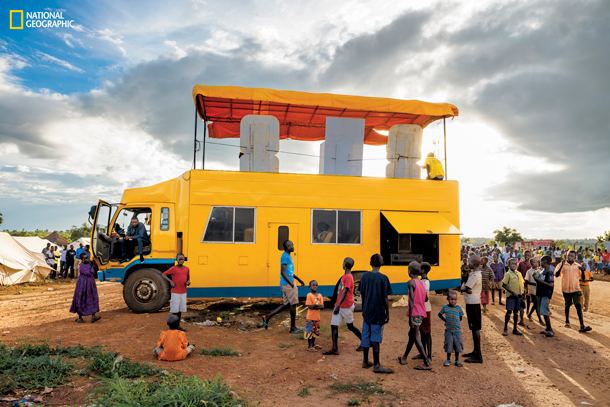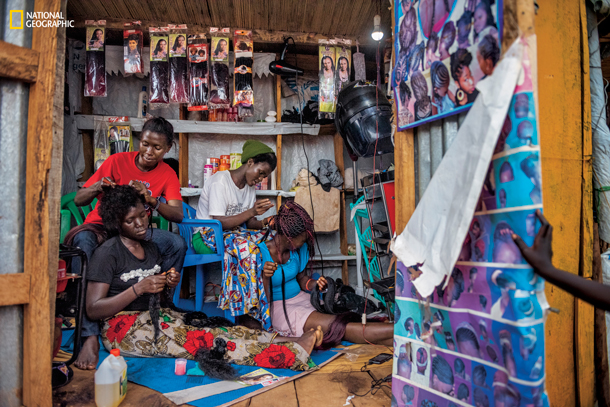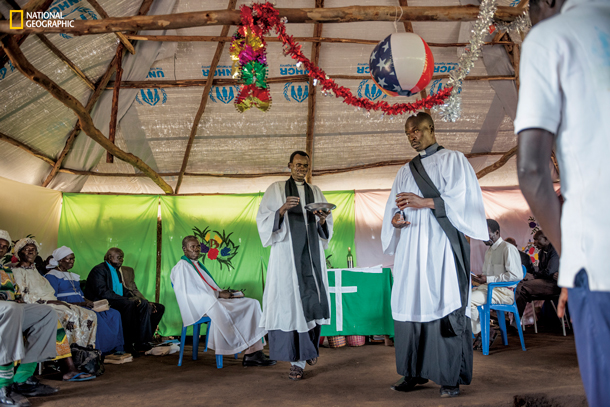A Refugee Camp Becomes a City
Air Date: Week of May 3, 2019

Photo of a mobile business in Bidibidi. (Photo: Nancy Ostertag, courtesy of National Geographic)
Driven by civil war, hundreds of thousands of South Sudanese families have fled their home country to neighboring Uganda in the last few years. In Uganda’s Bidibidi refugee camp, progressive policies that include local residents and enable refugees to live, farm, and work freely together are fostering the growth of small businesses and infrastructure. The goal: to attract outside investments and build a future city that could endure long beyond the refugees’ eventual return home. Nina Strochlic, a staff writer for National Geographic Magazine, sits down with Host Steve Curwood to discuss how temporary refugee camps can be transformed into rising cities.
Transcript
CURWOOD: From PRI and the Jennifer and Ted Stanley Studios at the University of Massachusetts Boston, this is Living on Earth. I’m Steve Curwood.
The category four cyclone Kenneth recently slammed ashore in sparsely populated northern Mozambique, killing dozens of people, displacing thousands, and setting off massive flooding. Kenneth was the strongest cyclone ever recorded in this part of Africa, and came on the heels of cyclone Idai in March. Idai was a category three storm before it barreled into Beira, a city of a half million further south in Mozambique. Idai killed nearly a thousand people, leveled more than 110,000 homes, and flooded many parts of Mozambique, Malawi and Zimbabwe. The scale of the devastation is massive and aid workers caution that long-term assistance and refugee camps will be necessary.
For inspiration, Mozambique might look north to Uganda, where the government and international agencies have taken an innovative approach to housing displaced persons by building more permanent facilities that serve both refugees and local residents. Bidibidi refugee camp houses roughly a quarter million South Sudanese who fled civil war in their country. Until recently it was the largest refugee camp in the world. Nina Strochlic recently traveled to Bidibidi for National Geographic magazine and joins me now.
STROCHLIC: Thanks so much for having me, Steve.
CURWOOD: What was the landscape like when South Sudanese refugees first settled in Uganda?
STROCHLIC: Well, when refugees started coming over the border with Uganda in late 2016, they were more or less entering a forest. They were in a very densely forested area that had to be immediately adapted to fit the tens of thousands of people who were coming to stay. So they ended up clearing acres and acres of land, and the first thing they did was they made 250 miles of roads going through.
CURWOOD: Oh my. Nina, I understand that there are now around a quarter million, perhaps 250,000, South Sudanese individuals in Bidibidi. So what about access to food and water?
STROCHLIC: Yeah, well there's a really interesting way of managing that that they have created in Bidibidi. So every month South Sudanese refugees get corn and oil and sort of the basic staples that they need to survive, but it's certainly not enough for a family. So what they've done in Bidibidi is they've given everyone plots of land. And on those plots, people build their homes, sort of a family-style cluster of homes. And they also have room to grow food, so fruits and vegetables, maybe peanuts to make peanut butter to sell, sunflowers to make oil, things that they can supplement their diet with. And they are also able to get a second area of land a little bit outside of camp center where they can do more agriculture and use that as a job and a way to survive. What you see when you first enter Bidibidi is that it doesn't feel like a refugee camp where you're imagining tons of white tents crammed together, tarps, really temporary-looking structures. You see solidly-built, small huts with thatched roofs like you might find across East Africa. And around that, little areas of land that people are using to farm.
CURWOOD: These are nice resources to have in East Africa, where there are many, many challenges. What access do Ugandans have to these facilities? Or are they strictly available for refugees?
STROCHLIC: One of the major sort of turning points in the international response in Uganda and for the South Sudanese crisis was that the Ugandan officials wanted to make sure that an influx of hundreds of thousands of people, over a million at this point, wouldn't create tensions with local populations. So what they did to ensure that locals would feel that the refugees were not taking resources that might have been available for them, is they earmarked 30% of all international funding to go towards local amenities. So what that means on the ground, for example, is if a school is built, they're hoping to get 30% of those students as local students, 70% refugees. If a health center is built, they want 30% of the resources from that to go to local communities. So that it's more of a shared benefit and it doesn't feel like the government and the international community only cares about the refugee population and doesn't care about normal Ugandans.
CURWOOD: So how is that 30% number arrived at, do you think?
STROCHLIC: In 2016, the UN announced its comprehensive Refugee Response Framework, which is basically aimed at trying to get host populations to incorporate refugees more into their economy, and saying, you know, it doesn't serve anyone to stick a bunch of people in a remote area, having them live on food rations and in tents, and unable to work, unable to do anything to help themselves for, it could be, decades. There are camps around the world that have existed for decades and decades and still haven't, you know, been fully utilized, where people feel that they are able to sort of self-sustain. So how you see this new policy play out on the ground, is that the schools, the health centers, and other infrastructure are being built for permanence. So they're not tarps, though there still are some temporary structures. But for the most part, they're very nice looking brick and mortar buildings. And the hope is that, regardless of how long the refugees stay there, those buildings will last and they'll serve the local population for years to come.
CURWOOD: Let's cut to the chase though: there has to be economic activity. So how at Bidibidi are people able to have incomes and move forward with setting up a life for themselves, not just existing, but having a life?

Hair salons are a hot commodity in Bidibidi just like any other city. (Photo: Nancy Ostertag, courtesy of National Geographic)
STROCHLIC: People I spoke to who had been there in the early days said, of course, supply and demand. So when people started coming over the border, it was not long at all until a market popped up around that main reception area. And now you can see markets in every zone of the camp and within villages in each of those zones. So there's definitely a small-scale economy that is flourishing in the camp. A lot of what you see are small snack stands, people selling the produce that they're growing outside of their plots, used clothing markets, seamstresses, and then there are even the things that you would find in a normal city to entertain yourself. There are TV halls all around the camp, where people can pay a small amount of money and watch Nigerian movies or soccer games, or the World Cup that's going on. There are, you know, places where people will just relax and, like we would anywhere in the world, play pool or dominoes or, you know, get their hair cut.
CURWOOD: Uganda is not exactly one of the wealthiest places on the planet itself. The government is stable these days, but they need a lot as well. So how are locals reacting to Bidibidi becoming a more intentional, more supported settlement, become a city, really?
STROCHLIC: The locals who I interacted with were mostly within the camp or lived in the towns and the villages, sort of interspersed within many zones of Bidibidi, and people said they were really hoping for employment opportunities in that area. Specifically, these large humanitarian organizations who come in and hire drivers and cooks and construction workers and all of these things. And I think they were a little disappointed that there weren't more opportunities for them to work for the large NGOs who are operating around Bidibidi right now. But people then would also say, you know, that they could come into the camp, they could go to the health clinic, they could get medical attention that they were not able to get before. They could send their kids to school if they were living right next to one of the camp zones. And it also provided potential markets. So there were vendors in the markets, who were local Ugandans, who saw this large influx of people and thought, hey, if I open a charging station, people need to charge their phones, they'll pay me a little bit of money for that. Or I could import sodas from Kampala, eight hours south of the camp, and bring in things that aren't readily available in the region and sell them and get some income that way. So local Ugandans are definitely seeing benefits of having a quarter million new people moving into the North. But I wouldn't say they're overjoyed at it. And I think that's what makes the efforts of the Ugandan government to ensure that there's sort of this shared benefit for both locals and refugees really important because without that dialogue going on, tensions can arise. And that's where conflict becomes possible as well.
CURWOOD: So if Bidibidi is so successful as a refugee camp, what happens suddenly if South Sudan is a peaceful place, and refugees could go back? What will happen to this city, do you think?

A church service being held at Bidibidi (Photo: Nancy Ostertag, courtesy of National Geographic)
STROCHLIC: So the idea is that in the future, say it's possible for South Sudanese refugees to return home, I think many people would like to do that, even though they understand that could be many years from now. But the infrastructure that remains is intended to be put to use for local Ugandan communities. That's how the camp was built, with that future in mind. And if it doesn't come to fruition, well then, it will be used by South Sudanese for years to come. Or if it does, it'll hopefully be integrated into Uganda and used by Ugandan locals.
CURWOOD: Nice problem to have, I imagine.
STROCHLIC: Yeah.
CURWOOD: So refugee camps are big business these days on this planet, whether it's a conflict zone, in Syria, or in Bangladesh, where the Rohingya have had to flee. But also in Bangladesh, you have climate refugees. What do you think the United States could learn from the experience of Bidibidi when it comes to dealing with refugees who come to our borders?
STROCHLIC: I think there's definitely a beneficial lesson in Bidibidi that shows that if refugees are given the opportunity, they will do everything they can to become self-sufficient. And that, in the end, can benefit the society as a whole. So there are a lot of people in the international community thinking now that we've existed for hundreds of years in this sort of mindset where refugees are just to be temporarily held and then returned as quickly as possible to the country where they came from. But that almost never happens. There are statistics that show that refugees stay in exile for 10 years on average now, and certainly with some of the wars that we're seeing happen in the world that could be a lot longer. So trying to change that mindset is really something that's on the table now, on the international level. And I think that in the US we could be looking at that as well.
CURWOOD: Nina Strochlic's article about Bidibidi is in the April issue of National Geographic. Nina, thanks so much for taking the time with us today.
STROCHLIC: Thanks, Steve. It was great to talk with you.
Links
How Bidibidi Uganda Refugee Camps Became a City
American Refugee Committee | Welcome to the Bidibidi Refugee Settlement
Living on Earth wants to hear from you!
Living on Earth
62 Calef Highway, Suite 212
Lee, NH 03861
Telephone: 617-287-4121
E-mail: comments@loe.org
Newsletter [Click here]
Donate to Living on Earth!
Living on Earth is an independent media program and relies entirely on contributions from listeners and institutions supporting public service. Please donate now to preserve an independent environmental voice.
NewsletterLiving on Earth offers a weekly delivery of the show's rundown to your mailbox. Sign up for our newsletter today!
 Sailors For The Sea: Be the change you want to sea.
Sailors For The Sea: Be the change you want to sea.
 The Grantham Foundation for the Protection of the Environment: Committed to protecting and improving the health of the global environment.
The Grantham Foundation for the Protection of the Environment: Committed to protecting and improving the health of the global environment.
 Contribute to Living on Earth and receive, as our gift to you, an archival print of one of Mark Seth Lender's extraordinary wildlife photographs. Follow the link to see Mark's current collection of photographs.
Contribute to Living on Earth and receive, as our gift to you, an archival print of one of Mark Seth Lender's extraordinary wildlife photographs. Follow the link to see Mark's current collection of photographs.
 Buy a signed copy of Mark Seth Lender's book Smeagull the Seagull & support Living on Earth
Buy a signed copy of Mark Seth Lender's book Smeagull the Seagull & support Living on Earth

